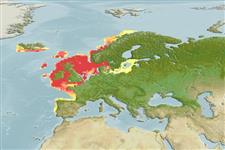>
Gadiformes (Cods) >
Gadidae (Cods and haddocks)
Etymology: Pollachius: Scottish dialect, podlock, paddle = bumpfish (Ref. 45335).
More on author: Linnaeus.
Environment: milieu / climate zone / depth range / distribution range
Ecologia
marinhas bentopelágico; oceanódromo (Ref. 51243); intervalo de profundidade 40 - 200 m (Ref. 6302), usually 40 - 100 m (Ref. 54707). Temperate; 72°N - 36°N, 25°W - 28°E
Northeast Atlantic: Iceland, the Faeroes and Norway to the Bay of Biscay (Ref. 1371); also southern Baltic Sea (Ref. 89342) with records from Poland, Latvia and Estonia (Refs. 36252, 52079).
Length at first maturity / Tamanho / Peso / Idade
Maturity: Lm 41.0, range 42 - ? cm
Max length : 130 cm TL macho/indeterminado; (Ref. 1371); common length : 75.0 cm TL macho/indeterminado; (Ref. 1371); peso máx. Publicado: 18.1 kg (Ref. 40637); Idade máx. registada: 8 anos (Ref. 1371)
Espinhos dorsais (total): 0; Raios dorsais moles (total): 29-33; Raios anais moles: 27 - 30; Vértebras: 52 - 55. Lower jaw distinctly projecting beyond upper ones. Lacks a chin barbel. Dark lateral line that sharply curves over the pectoral fin and continues over whole body. No dark spot at pectoral fin base. Dorsal and anal fin interspaces short. Sensory canals with large pores on head. Body color is variable; dark dorsally, sharply distinguished from silver-gray sides and belly; the upper part of the body with yellow to orange streaks or blotches; the lateral line greenish. The fins uniformly dark except for the pelvic fins which are yellowish.
Found in inshore waters but also down to 200 m depth, in areas with hard bottoms. Juveniles are pelagic, spending 2-3 years near the coast including rocky areas, kelp beds, sandy shores and estuaries (Ref. 1371, 58137, 89343, 89362). Juveniles may form schools with saithe (Pollachius virens) (Ref. 88187), and have also been found solitary and defending their feeding territory (Refs. 42174, 89363). Larger individuals move to the open sea and are often found around rocky areas at 40-100 m depth (Ref. 1371). Also observed around shipwrecks and oil platforms (Ref. 88187). Adults occur singly or in small dispersed shoals but is known to form dense shoals on spawning grounds (Ref. 89364). Suggested to undertake spawning migrations (Ref. 88171). Caught as bycatch in cod and saithe fisheries. Flesh is dry but of good flavor (Ref. 35388). Classified as a "hearing generalist" (89365); has also been found to produce sound. Juveniles have been reported to make repeated short grunts during competitive feeding and aggressive encounters (89366).
Oviparous and gonochorous (Ref. 205).
Cohen, D.M., T. Inada, T. Iwamoto and N. Scialabba, 1990. FAO species catalogue. Vol. 10. Gadiform fishes of the world (Order Gadiformes). An annotated and illustrated catalogue of cods, hakes, grenadiers and other gadiform fishes known to date. FAO Fish. Synop. 125(10). Rome: FAO. 442 p. (Ref. 1371)
Categoria na Lista Vermelha da IUCN (Ref. 130435)
Ameaça para o homem
Harmless
Utilização humana
Pescarias: espécies comerciais; peixe desportivo: sim
Mais informação
ReferênciasAquaculturaPerfil para aquaculturaEstirpesGenéticaElectrophoresesHereditariedadeDoençasProcessamentoNutrientsMass conversion
Ferramentas
Relatórios especiais
Descarregue XML
Fontes da internet
Estimates based on models
Preferred temperature (Ref.
123201): 7 - 11.9, mean 8.9 °C (based on 283 cells).
Phylogenetic diversity index (Ref.
82804): PD
50 = 0.7500 [Uniqueness, from 0.5 = low to 2.0 = high].
Bayesian length-weight: a=0.00708 (0.00603 - 0.00831), b=3.08 (3.04 - 3.12), in cm total length, based on LWR estimates for this species (Ref.
93245).
Nível Trófico (Ref.
69278): 4.3 ±0.3 se; based on diet studies.
Generation time: 5.9 ( na - na) years. Estimated as median ln(3)/K based on 1
growth studies.
Resiliência (Ref.
120179): Médio, tempo mínimo de duplicação da população 1,4 - 4,4 anos (K=0.19; tmax=8).
Prior r = 0.63, 95% CL = 0.42 - 0.95, Based on 3 stock assessments.
Fishing Vulnerability (Ref.
59153): High vulnerability (59 of 100).
Climate Vulnerability (Ref.
125649): Very high vulnerability (82 of 100).
Nutrients (Ref.
124155): Calcium = 8.53 [3.62, 29.51] mg/100g; Iron = 0.222 [0.085, 0.575] mg/100g; Protein = 17.7 [15.7, 19.8] %; Omega3 = 0.544 [0.279, 1.082] g/100g; Selenium = 25.4 [8.6, 76.9] μg/100g; VitaminA = 17.8 [4.6, 71.0] μg/100g; Zinc = 0.401 [0.206, 0.797] mg/100g (wet weight);
